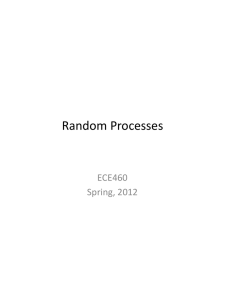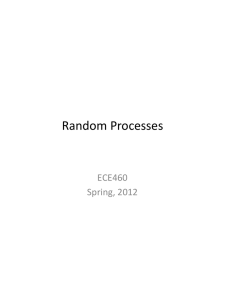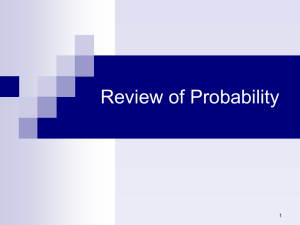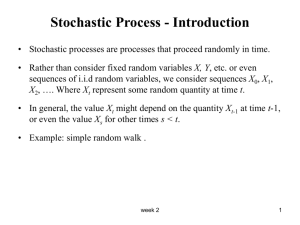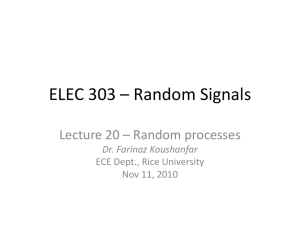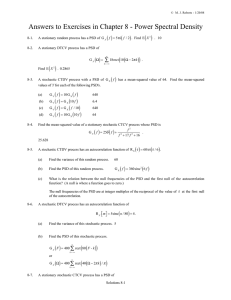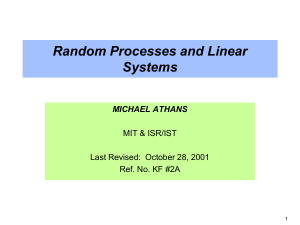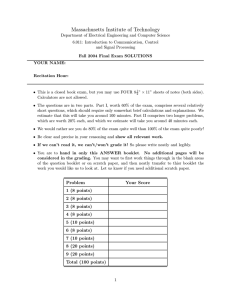Document
advertisement
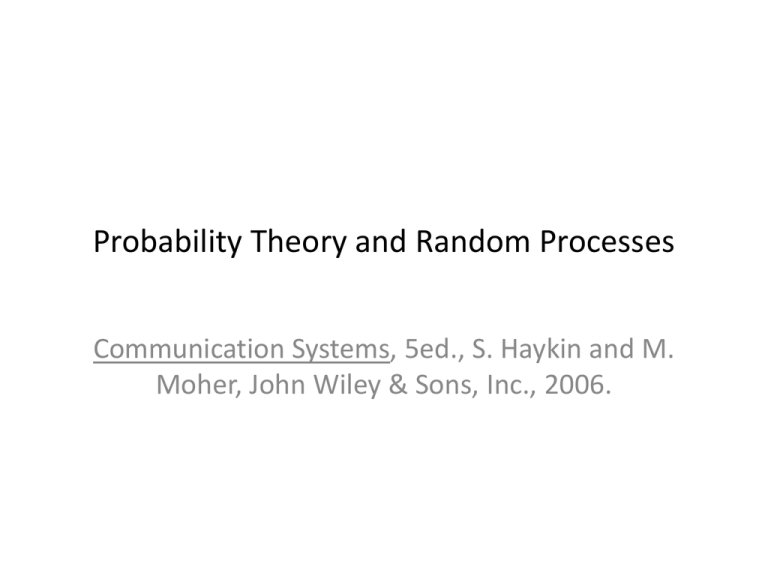
Probability Theory and Random Processes Communication Systems, 5ed., S. Haykin and M. Moher, John Wiley & Sons, Inc., 2006. Probability • Probability theory is based on the phenomena that can be modeled by an experiment with an outcome that is subject to chance. • Definition: A random experiment is repeated n time (n trials) and the event A is observed m times (m occurrences). The probability is the relative frequency of occurrence m/n. Probability Based on Set Theory • Definition: An experiment has K possible outcomes where each outcome is represented as the kth sample sk. The set of all outcomes forms the sample space S. The probability measure P satisfies the • Axioms: – 0 ≤ P[A] ≤ 1 – P[S] = 1 – If A and B are two mutually exclusive events (the two events cannot occur in the same experiment), P[AUB]=P [A] + P[B], otherwise P[AUB] = P[A] + P[B] – P[A∩B] – The complement is P[Ā] = 1 – P[A] – If A1, A2,…, Am are mutually exclusive events, then P[A1] + P[A2] + … + P[Am] = 1 Venn Diagrams sk Sample can only come from A, B, or neither. S A B Events A and B that are mutually exclusive events in the sample space S. Sample can only come from both A and B. sk S A Events A and B are not mutually exclusive events in the sample space S. B Conditional Probability • Definition: An experiment involves a pair of events A and B where the probability of one is conditioned on the occurrence of the other. Example: P[A|B] is the probability of event A given the occurrence of event B • In terms of the sets and subsets – P[A|B] = P[A∩B] / P[A] – P[A∩B] = P[A|B]P[B] = P[B|A]P[A] • Definition: If events A and B are independent, then the conditional probability is simply the elementary probability, e.g. P[A|B] = P[A], P[B|A] = P[B]. Random Variables • Definition: A random variable is the assignment of a variable to represent a random experiment. X(s) denotes a numerical value for the event s. • When the sample space is a number line, x = s. • Definition: The cumulative distribution function (cdf) assigns a probability value for the occurrence of x within a specified range such that FX(x) = P[X ≤ x]. • Properties: – 0 ≤ FX(x) ≤ 1 – FX(x1) ≤ FX(x2), if x1 ≤ x2 Random Variables • Definition: The probability density function (pdf) is an alternative description of the probability of the random variable X: fX(x) = d/dx FX(x) • P[x1 ≤ X ≤ x2] = P[X ≤ x2] - P[X ≤ x1] = FX(x2) - FX(x1) = fX(x)dx over the interval [x1,x2] Example Distributions • Uniform distribution xa 0, 1 f X ( x) , a xb b a xb 0, xa 0, x a FX ( x) , a xb b a xb 1, Several Random Variables • CDF: FX ,Y ( x, y ) PX x, Y y • Marginal cdf: • PDF: y x FX ( x) f X ,Y • Conditional pdf: f X ,Y (u , v) du dv f X ,Y (u , v) du dv 1 f X ( x) f 2 f X ,Y ( x, y) FX ,Y ( x, y) xy • Marginal pdf: FY ( y ) (u, v) du dv X ,Y ( x, v) dv f Y ( y | x) fY ( y ) f f X ,Y ( x, y) f X ( x) X ,Y (u , y ) du Statistical Averages • Expected value: X EX xf X x dx • Function of a random variable: EY Y g( X ) yf y dy Eg X g X f x dx Y • Text Example 5.4 X Statistical Averages • nth moments: x EX n n f X x dx 2 f X x dx x EX 2 Mean-square value of X • Central moments: x E X X n X n f X x dx x E X X 2 2 2 f x dx X X X Variance of X Joint Moments • Correlation: i E X ,Y k x y i k f X ,Y x, y dx dy Expected value of the product - Also seen as a weighted inner product • Covariance: covXY E X EX Y EY EXY X Y • Correlation coefficient: Correlation of the central moment uncorrelat ed covXY 0, X Y 1, strongly correlated Random Processes • Definition: a random process is described as a timevarying random variable X t X t EX t xf X t x dx • Mean of the random process: • Definition: a random process is first-order stationary if its pdf is constant f X t x f X t x X t X X2 t X2 Constant mean, variance 1 2 • Definition: the autocorrelation is the expected value of the product of two random variables at different times RX t1 , t2 EX t1 X t2 R t , t R t t Stationary to X 1 2 X 1 2 second order Random Processes • Definition: the autocorrelation is the expected value of the product of two random variables at different times RX t1 , t2 EX t1 X t2 RX t1 , t2 RX t1 t2 Stationary to second order • Definition: the autocovariance of a stationary random process is C X t1 , t2 E X t1 X X t2 X RX t1 t2 X2 Properties of Autocorrelation • Definition: autocorrelation of a stationary process only depends on the time differences RX EX t X t • Mean-square value: RX 0 E X 2 t • Autocorrelation is an even function: RX RX • Autocorrelation has maximum at zero: RX RX 0 Example • Sinusoidal signal with random phase X t A cos2f c t , 1 , - f t 2 0, otherwise • Autocorrelation RX EX t X A2 cos2f c 2 As X(t) is compared to itself at another time, we see there is a periodic behavior it in correlation Cross-correlation • Two random processes have the cross-correlation X t , Y t RXY t , u EX t Y u • Wide-sense stationary cross-correlation RX t , RX t , RY u, RY u RXY , u RXY Example • Output of an LTI system when the input is a RP • Text 5.7 Power Spectral Density • Definition: Fourier transform of autocorrelation function is called power spectral density SX f j 2f R e dτ X R X τ j 2f S f e df X • Consider the units of X(t) Volts or Amperes • Autocorrelation is the projection of X(t) onto itself • Resulting units of Watts (normalized to 1 Ohm) Properties of PSD • Zero-frequency of PSD S X 0 R dτ X • Mean-square value S E X 2 t Which theorem does this property resemble? • PSD is non-negative • PSD of a real-valued RP SX f 0 S X f S X f X f df Example • Text Example 5.12 – Mixing of a random process with a sinusoidal process Y t X t cos2f ct Wide-sense stationary RP (to make it easier) Uniformly distributed, but not time-varying – Autocorrelation RY EY t Y t – PSD SY f 1 RX cos2f c 2 1 SY f f c SY f f c 4 PSD of LTI System • Start with what you know and work the math Y t ht * X t SY f R e Y j 2f dτ SY f EY t Y t e j 2f d Eht * X t ht * X t e j 2f d j 2f d E h 1 X t 1 d 1 h 2 X t 2 d 2 e j 2f d 1 d 2 d e t X t X E h h 2 1 2 1 PSD of LTI System • The PSD reduces to SY f j 2f h h R e d 1 d 2 d 1 2 1 2 X Change of variables 1 2 0 0 1 2 SY f j 2f 0 1 2 h h R e d 1 d 2 d 0 0 2 0 1 X 0 SY f H f S X f 2 System shapes power spectrum of input as expected from a filtering like operation Gaussian Process • The Gaussian probability density function for a single variable is y Y 2 1 fY y exp 2 2 Y 2 Y • When the distribution has zero mean and unit variance y2 1 fY y exp 2 2 • The random variable Y is said to be normally distributed as N(0,1) Properties of a Gaussian Process • The output of a LTI is Gaussian if the input is Gaussian • The joint pdf is completely determined by the set of means and autocovariance functions of the samples of the Gaussian process • If a Gaussian process is wide-sense stationary, then the output of the LTI system is strictly stationary • A Gaussian process that has uncorrelated samples is statistically independent Noise • Shot noise • Thermal noise • White noise • Narrow
